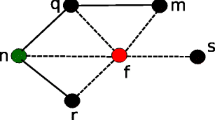Abstract
Unstructured overlay networks are driven by simple protocols that are easy to analyze and implement. The lack of structure, however, leads to weak message delivery guarantees and poor scaling. Structured overlays impose a global overlay topology that is then maintained by all peers in a complex protocol. In contrast to unstructured approaches the structured overlays are efficient and scalable, but leave little flexibility in how their topology can be adapted to the needs of the application.
We propose a generic overlay maintenance and routing algorithm that combines the simplicity of the unstructured overlays and the scalability of the structured approaches, while allowing the application to define its own peer identifier space. The overlay topology is not explicitly defined but emerges in a self-organized way as the result of simple maintenance rules. Independently of the identifier space used, our algorithm exhibits logarithmic scaling of the average routing path length and the average node degree.
The proposed maintenance and routing algorithm is simple and places few constraints on how peers can open their connections. This together with the ability to adjust both the identifier space and the tradeoff between the path length and the node degree makes the overlay customizable in ways that are not possible in the existing approaches.
Preview
Unable to display preview. Download preview PDF.
Similar content being viewed by others
References
Stoica, I., Morris, R., Karger, D., Kaashoek, F., Balakrishnan, H.: Chord: A scalable Peer-To-Peer lookup service for internet applications, pp. 149–160.
Aberer, K., Cudré-Mauroux, P., Datta, A., Despotovic, Z., Hauswirth, M., Punceva, M., Schmidt, R.: P-Grid: a self-organizing structured P2P system. SIGMOD Record 32(3), 29–33 (2003)
Zhao, B.Y., Kubiatowicz, J.D., Joseph, A.D.: Tapestry: An infrastructure for fault-tolerant wide-area location and routing. Technical Report UCB/CSD-01-1141, UC Berkeley (April 2001)
Rowstron, A., Druschel, P.: Pastry: Scalable, decentralized object location, and routing for large-scale peer-to-peer systems. In: Guerraoui, R. (ed.) Middleware 2001. LNCS, vol. 2218, pp. 329–337. Springer, Heidelberg (2001)
Maymounkov, P., Mazieres, D.: Kademlia: A peer-to-peer information system based on the xor metric (2002)
Bharambe, A.R., Agrawal, M., Seshan, S.: Mercury: supporting scalable multi-attribute range queries. In: SIGCOMM 2004. Proceedings of the 2004 conference on Applications, technologies, architectures, and protocols for computer communications, pp. 353–366. ACM Press, New York (2004)
Ratnasamy, S., Francis, P., Handley, M., Karp, R., Schenker, S.: A scalable content-addressable network. In: Proceedings of the 2001 conference on applications, technologies, architectures, and protocols for computer communications, pp. 161–172. ACM Press, New York (2001)
Manku, G., Bawa, M., Raghavan, P.: Symphony: Distributed hashing in a small world (2003)
Aberer, K., Alima, L.O., Ghodsi, A., Girdzijauskas, S., Hauswirth, M., Haridi, S.: The essence of P2P: A reference architecture for overlay networks. In: P2P 2005, The 5th IEEE International Conference on Peer-to-Peer Computing (2005)
Clarke, I., Sandberg, O., Wiley, B., Hong, T.W.: Freenet: A distributed anonymous information storage and retrieval system. In: Federrath, H. (ed.) Designing Privacy Enhancing Technologies. LNCS, vol. 2009, pp. 46–53. Springer, Heidelberg (2001)
Ripeanu, M.: Peer-to-peer architecture case study: Gnutella network (2001)
Protopeer, http://lsirpeople.epfl.ch/galuba/protopeer
Bustamante, F., Qiao, Y.: Friendships that last: Peer lifespan and its role in (2003)
Kleinberg, J.: The Small-World Phenomenon: An Algorithmic Perspective. In: Proceedings of the 32nd ACM Symposium on Theory of Computing, ACM Press, New York (2000)
Li, J., Stribling, J., Morris, R., Kaashoek, M.F.: Bandwidth-efficient management of DHT routing tables. In: Proceedings of the 2nd USENIX Symposium on Networked Systems Design and Implementation (NSDI 2005), Boston, Massachusetts (May 2005)
Newman, M.: The structure and function of complex networks (2003)
Albert, R., Barabási, A.: Statistical mechanics of complex networks.
Watts, D.J., Strogatz, S.H.: Collective dynamics of ”small-world” networks. Nature 393, 440–442 (1998)
Author information
Authors and Affiliations
Editor information
Rights and permissions
Copyright information
© 2007 Springer-Verlag Berlin Heidelberg
About this paper
Cite this paper
Galuba, W., Aberer, K. (2007). Generic Emergent Overlays in Arbitrary Peer Identifier Spaces. In: Hutchison, D., Katz, R.H. (eds) Self-Organizing Systems. IWSOS 2007. Lecture Notes in Computer Science, vol 4725. Springer, Berlin, Heidelberg. https://doi.org/10.1007/978-3-540-74917-2_9
Download citation
DOI: https://doi.org/10.1007/978-3-540-74917-2_9
Publisher Name: Springer, Berlin, Heidelberg
Print ISBN: 978-3-540-74916-5
Online ISBN: 978-3-540-74917-2
eBook Packages: Computer ScienceComputer Science (R0)




